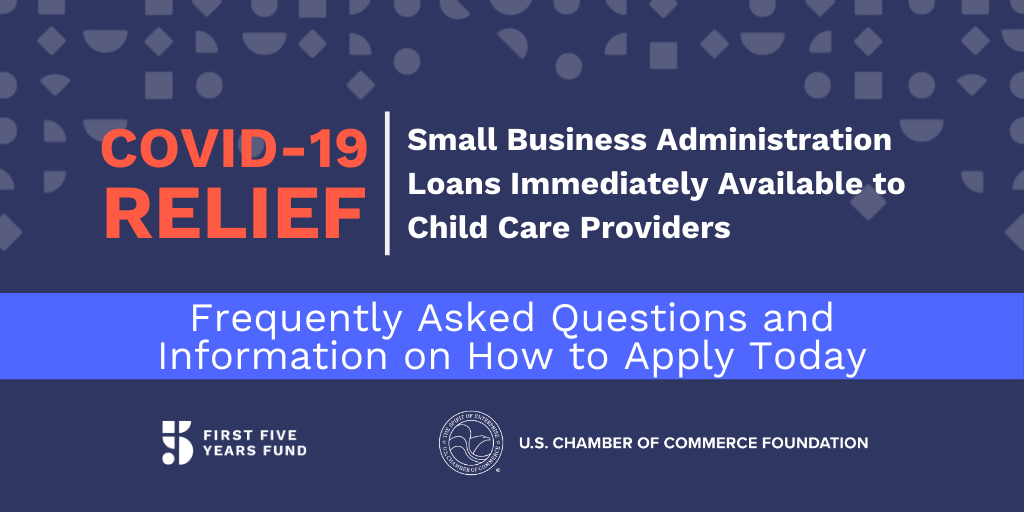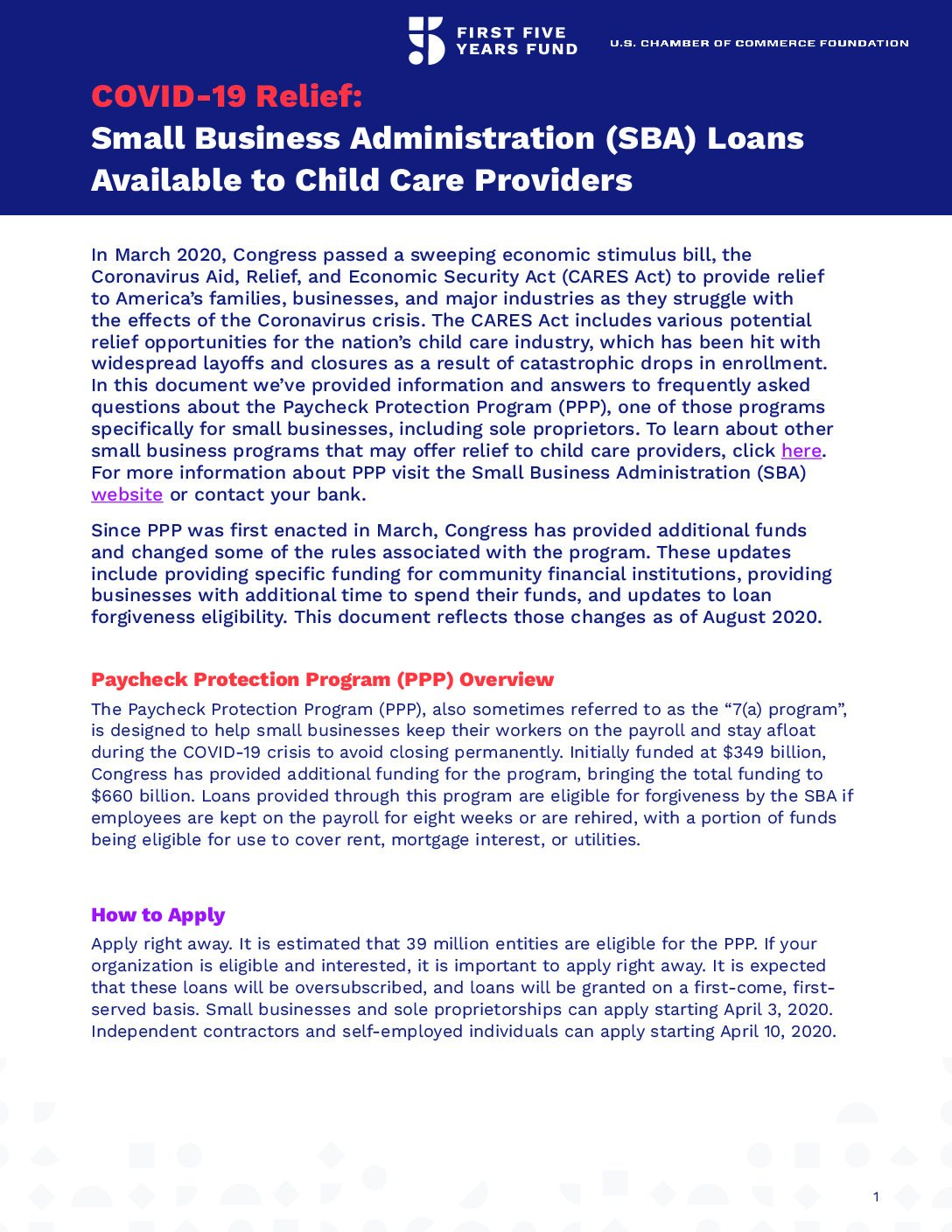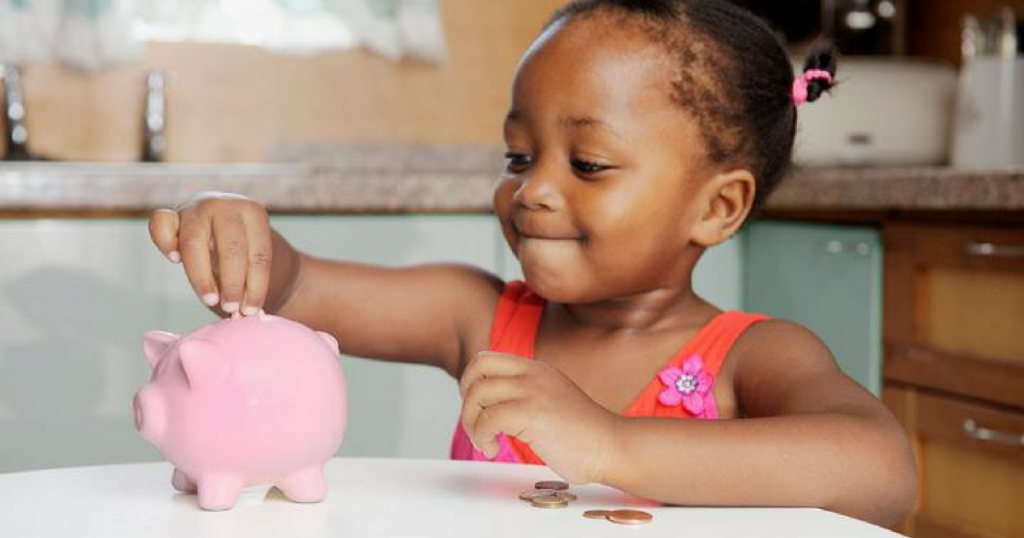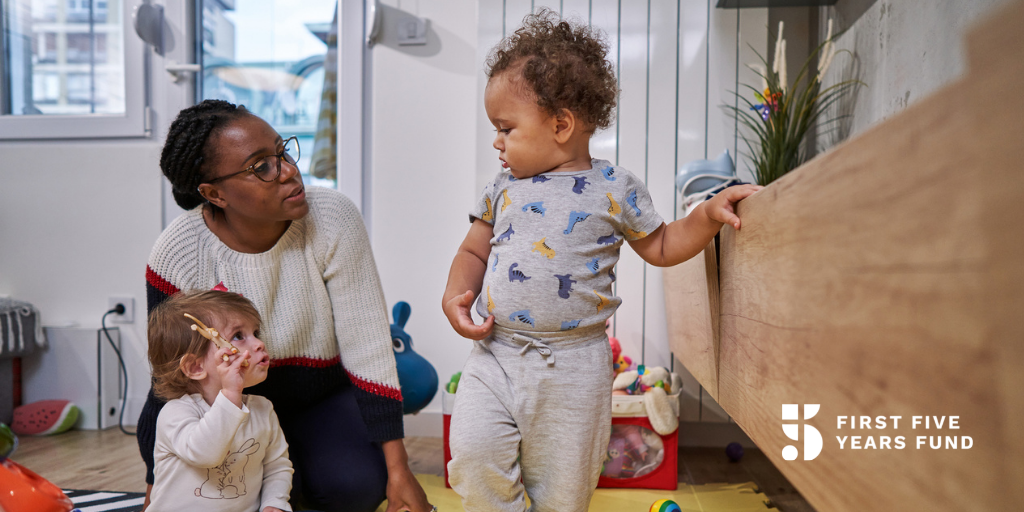Small Business Administration (SBA) Loans Immediately Available to Child Care Providers

The following is information provided by First Five Years Fund and the U.S. Chamber of Commerce Foundation for child care small businesses interested in applying for a loan through Paycheck Protection Program (PPP). For the best information specific to you and your business, contact your bank or financial lender.

In March 2020, Congress passed a sweeping economic stimulus bill, the Coronavirus Aid, Relief, and Economic Security Act (CARES Act) to provide relief to America’s families, businesses, and major industries as they struggle with the effects of the Coronavirus crisis. The CARES Act includes various potential relief opportunities for the nation’s child care industry, which has been hit with widespread layoffs and closures as a result of catastrophic drops in enrollment. In this document we’ve provided information and answers to frequently asked questions about the Paycheck Protection Program (PPP), one of those programs specifically for small businesses, including sole proprietors. To learn about other small business programs that may offer relief to child care providers, click here. For more information about PPP visit the Small Business Administration (SBA) website or contact your bank.
Since PPP was first enacted in March, Congress has provided additional funds and changed some of the rules associated with the program. These updates include providing specific funding for community financial institutions, providing businesses with additional time to spend their funds, and updates to loan forgiveness eligibility. This document reflects those changes as of August 2020.
Paycheck Protection Program (PPP) Overview
The Paycheck Protection Program (PPP), also sometimes referred to as the “7(a) program”, is a program designed to help small businesses keep their workers on the payroll and stay afloat during the COVID-19 crisis to avoid closing permanently. Initially funded at $349 billion, Congress has provided additional funding for the program, bringing the total funding to $660 billion. Loans provided through this program are eligible for forgiveness by the SBA if employees are kept on the payroll for eight weeks or are rehired, with a portion of funds being eligible for use to cover rent, mortgage interest, or utilities.
How to Apply:
Apply Right Away:
Apply right away. It is estimated that 39 million entities are eligible for the PPP. If your organization is eligible and interested, it is important to apply right away. It is expected that these loans will be oversubscribed, and loans will be granted on a first-come, first-served basis. Small businesses and sole proprietorships can apply starting April 3, 2020. Independent contractors and self-employed individuals can apply starting April 10, 2020.
Apply Directly Through Your Local Lender:
You can apply directly through any existing SBA 7(a) lender or through any federally insured depository institution, federally insured credit union, and Farm Credit System institution that is participating by:
- Contacting your local bank or lender to ask if they are participating in the SBA 7(a) program. If your bank does not participate, ask if they have a relationship with a bank or credit union that does.
- Calling your local Small Business Development Center.
- Visiting the SBA website and look up a list of participating financial institutions. (Other regulated lenders will be available to make these loans once they are approved and enrolled in the program.)
Streamlined Application Process:
The application process has been streamlined to ensure small business can be approved quickly as possible. To apply you will need the following documentation:
To view the initial application click here
Additionally, the application for Loan Forgiveness can be found here.
Payroll documentation is all that is needed with your application:
- 2019 IRS forms (tax return or 990) if this year’s taxes have been completed.
- If you have not yet filed 2019 taxes, a 2018 return can be used. You’ll need a complete end-of-year income, expense and asset statements.
Frequently Asked Questions
What is considered a “business” under this program?
- 501(c)(3) non-profit organizations with fewer than 500 employees
- Small businesses with fewer than 500 employees
- Self-employed individuals
- Sole proprietors
- Independent contractors
- Tribal business concerns that meet the SBA size standard
What about religious organizations?
Religious organizations are eligible but only to cover payroll costs or an associated business, like a thrift store or child care center.
How much can I borrow?
Eligible entities are eligible to borrow 2.5 times their average monthly payroll expenses or up to $10 million, whichever amount is less. This amount is intended to help cover eight weeks of payroll expenses as well as mortgage interest, rent, and utilities. In June 2020, Congress extended the amount of time that borrowers have to spend their PPP loans until December 2020.
What is the deadline to apply?
The deadline to apply for PPP was extended through August 8, 2020.
What can the loan be used for?
The loan can be used to pay:
- Payroll costs including salary (up to an annual rate of $100,000)
- Wages
- Employee group health care benefits, including insurance premiums
- Retirement contributions
- Paid sick or medical leave
- Rent
- Leases
- Utilities
- Existing interest payment on mortgages
Does the loan have to be repaid? If so, how much?
If you meet all the requirements of this loan, it becomes a grant and is forgiven for the total of an eight-week period of payroll, rent, leases, utilities and existing interest payments on mortgages. Part of the loan can also be used for other business-related expenses, like supplies, but that portion of the loan will not be forgiven.
In June 2020, Congress reduced the amount of the loan that has to be spent on payroll, as compared with other allowable expenses such as rent or utilities. The most recent updates require that 60% of the loan be spent on payroll.
What if I lay off employees?
If after receiving the loan a business lays off employees, the forgiveness will be reduced by the percent decrease in the number of employees. In other words, if total payroll expenses (on workers making less than $100,000 annually) decreases by 25 percent, loan forgiveness will be reduced by the same amount.
An update to PPP in June 2020 includes an exemption to the forgivable loan amount determined by full-time equivalent employees if businesses can show that they were unable to rehire or hire a similarly qualified employee or that they were unable to return to the same business activity due to federal COVID-19 guidance.
What if I already laid off employees or reduced their wages?
If employees have already been laid off as a result of COVID-19 related hardship prior to applying for this loan, a business can rehire the employees and still be forgiven for the full amount of payroll cost for the eight weeks as long as the employees are rehired by December 2020, which is an extension from the original date.
If you do not rehire staff, the amount of your loan that will be forgiven may be reduced. (See above)
When is the loan forgiven?
The loan is forgiven at the end of the eight-week period if you meet all the requirements of the loan. Borrowers will work directly with their bank or other lender to verify covered expenses and the proper amount of forgiveness.
What if I already have other debt or a line of credit?
You are still eligible for the PPP. However, before applying, make sure you are not prevented from doing so because of other debt requirements.
If I already have a loan from the SBA can I still participate in the PPP?
Yes, you can still participate in PPP even if you have another loan from the SBA.
What will happen to my other SBA loan payments?
Under the CARES Act, your other SBA loan payments can be deferred for six months. Starting no later than 30 days after the date on which the first payment is due, the SBA will pay all principal, interest, and fees on existing SBA loans for six months pursuant to 7(a), Community Advantage, 504, and Microloan programs. If the loan is currently in deferment, then the SBA will begin making payments after the deferment period.
What are the interest rates and terms for the PPP loan amount that is not forgiven?
Any amount of the loan not forgiven will continue on as a five-year loan with an interest rate of 0.5% and is 100% guaranteed by the SBA. Additionally, updates to the program in June 2020 allow recipients to defer loan payments until they receive compensation for the forgiven amounts.
Am I responsible for interest on the forgiven loan amount?
No. If the full principal of the PPP loan is forgiven, the borrower is not responsible for interest accrued in the eight-week covered period.
What fees do you have to pay?
None. The cost of participation in the program is waived for both borrowers and lenders. The loan also includes an automatic deferment of payments for six months, and no prepayment penalties.
Do I need to pledge any collateral for these loans?
No collateral is required.
Do I need to personally guarantee this loan?
There is no personal guarantee requirement.
Note: If the proceeds are used for fraudulent purposes, the U.S. government will pursue criminal charges against you.
What do I need to certify?
As part of your application, you need to certify in good faith that:
- Current economic uncertainty makes the loan necessary to support your ongoing operations.
- The funds will be used to retain workers and maintain payroll or to make mortgage, lease, and utility payments.
- You have not and will not receive another loan under the PPP program.
- You will provide documentation to the lender that verifies the number of full-time equivalent employees on payroll and the dollar amounts of payroll costs, covered mortgage interest payments, covered rent payments, and covered utilities for the eight weeks after getting this loan.
- Loan forgiveness will be provided for the sum of documented payroll costs, covered mortgage interest payments, covered rent payments, and covered utilities. Due to likely high subscription, it is anticipated that not more than 25% of the forgiven amount may be for non-payroll costs.
- All the information you provided in your application and in all supporting documents and forms is true and accurate. Knowingly making a false statement to get a loan under this program is punishable by law.
- You acknowledge that the lender will calculate the eligible loan amount using the tax documents you submitted. You affirm that the tax documents are identical to those you submitted to the IRS. And you also understand, acknowledge, and agree that the lender can share the tax information with the SBA’s authorized representatives, including authorized representatives of the SBA Office of Inspector General, for the purpose of compliance with SBA Loan Program Requirements and all SBA reviews.
Are there other changes to PPP since the CARES Act was first enacted?
Yes. In addition to what is noted above, PPP has seen several changes, including:
- Elimination of a provision that would have limited the ability to defer payroll tax payments. The new update allows all PPP borrowers to defer payroll taxes.
- In April, Congress increased funding for PPP and set-aside for loans to be made by certain financial institutions including Depository Institutions and Credit Unions and Community Financial Institutions, Small Insured Depository Institutions, and Credit Unions.
How can I apply for PPP forgiveness?
The application for Loan Forgiveness can be found here.
Subscribe to FFYF First Look
Every morning, FFYF reports on the latest child care & early learning news from across the country. Subscribe and take 5 minutes to know what's happening in early childhood education.




